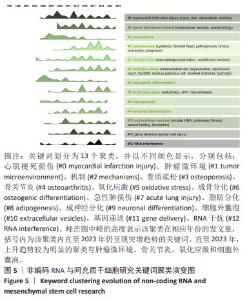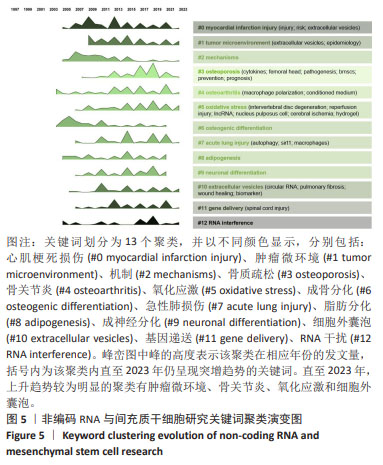Chinese Journal of Tissue Engineering Research ›› 2025, Vol. 29 ›› Issue (1): 87-94.doi: 10.12307/2025.006
Previous Articles Next Articles
A bibliometric analysis of non-coding RNA and mesenchymal stem cell research
Zhou Jiaxin, Tao Jiang
- Department of General Dentistry, Shanghai Ninth People’s Hospital, Shanghai Jiao Tong University School of Medicine; College of Stomatology, Shanghai Jiao Tong University; National Center for Stomatology; National Clinical Research Center for Oral Diseases; Shanghai Key Laboratory of Stomatology; Shanghai Research Institute of Stomatology; Research Unit of Oral and Maxillofacial Regenerative Medicine, Chinese Academy of Medical Sciences, Shanghai 200011, China
-
Received:2023-11-23Accepted:2023-12-21Online:2025-01-08Published:2024-05-18 -
Contact:Tao Jiang, MD, Chief physician, Doctoral supervisor, Department of General Dentistry, Shanghai Ninth People’s Hospital, Shanghai Jiao Tong University School of Medicine; College of Stomatology, Shanghai Jiao Tong University; National Center for Stomatology; National Clinical Research Center for Oral Diseases; Shanghai Key Laboratory of Stomatology; Shanghai Research Institute of Stomatology; Research Unit of Oral and Maxillofacial Regenerative Medicine, Chinese Academy of Medical Sciences, Shanghai 200011, China -
About author:Zhou Jiaxin, Master candidate, Physician, Department of General Dentistry, Shanghai Ninth People’s Hospital, Shanghai Jiao Tong University School of Medicine; College of Stomatology, Shanghai Jiao Tong University; National Center for Stomatology; National Clinical Research Center for Oral Diseases; Shanghai Key Laboratory of Stomatology; Shanghai Research Institute of Stomatology; Research Unit of Oral and Maxillofacial Regenerative Medicine, Chinese Academy of Medical Sciences, Shanghai 200011, China -
Supported by:National Natural Science Foundation of China, No. 82170922 (to TJ)
CLC Number:
Cite this article
Zhou Jiaxin, Tao Jiang. A bibliometric analysis of non-coding RNA and mesenchymal stem cell research[J]. Chinese Journal of Tissue Engineering Research, 2025, 29(1): 87-94.
share this article
Add to citation manager EndNote|Reference Manager|ProCite|BibTeX|RefWorks
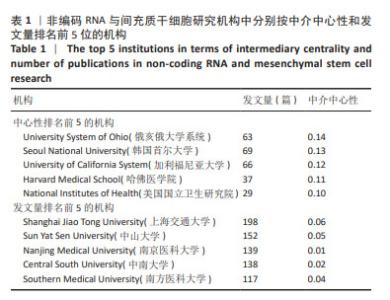
2.1 发文趋势分析结果 利用Web of Science核心集数据库检索关于非编码RNA与间充质干细胞研究相关的文献,文献数量共7 558篇,限定语言为英语且文章类型为“Article”后为5 848篇,使用CiteSpace6.2.R4软件进行查重,去除重复的500篇文献后,最后为5 348篇文献。最早的文献可追溯至1997年,1997-2023年的年发文量见图1A;2003-2011年的发文量呈指数增长趋势(R2=0.997 2);2012-2021年,文献发文量继续增长,表现为线性增长趋势(R2=0.974 9),2021年的年发文量最大,达729篇,2022年回落,2023年发文量未统计全年。按国家/地区统计累计发文量,共包括79个国家/地区,其中中国的累计发文量最大,占50.2%,为3 191篇,见图1B。 2.2 研究机构合作关系网络及贡献 据统计,共202个研究机构纳入分析。由VOSviewer 1.6.20软件生成机构合作网络图,见图2,每个节点为研究机构,节点大小与机构发文量呈正比,两节点连线表示机构间存在合作关系。其中,合作强度排名前3的机构依次为上海交通大学、中国医学科学院和南京医科大学,主要为中国机构间的合作,国际机构间的合作较少。按研究机构统计累计发文量,其中发文量排名前3的机构分别是上海交通大学(198篇)、中山大学(152篇)和南京医科大学(139篇)。 另外,计算了各个研究机构的中介中心性,见表1。中介中心性衡量了节点在网络中位置的重要性。中介中心性指的是一个节点(例如一个国家或一篇文章)在其他节点之间的最短路径上出现的次数[13]。中介中心性高( > 0.1)的节点被认为是关键枢纽,在网络图中被标记为紫色外圈。按中心性排名前3位的机构分别为俄亥俄大学系统(0.14)、韩国首尔大学(0.13)和加利福尼亚大学(0.12)。"
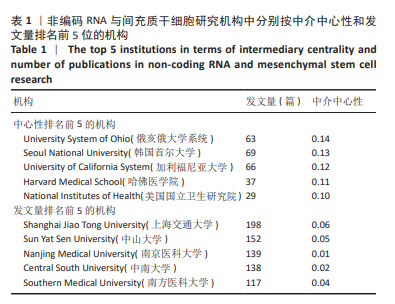
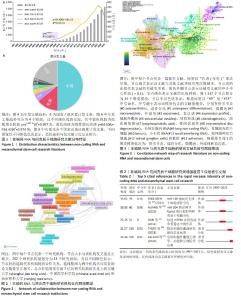
2.3 共被引用网络及突增性分析结果 共被引用分析是一种用于评估文献之间相互关系的科学计量学方法。当2篇或多篇学术文献同时被后续文献引用,可视为共被引文献[14]。在共被引用网络图中,每一个节点代表一篇学术文献,节点的大小与该文献的被引用频率呈正比,节点的颜色表示文献的出版时间,两个节点之间的连线反映它们的共被引关系。 共被引网络图中呈现聚类模块规模排名前14的聚类模块,并以不同色块标志,见图3。采用模块度(modularity)和加权平均轮廓系数(Weighted mean silhouette)用来衡量网络被分割成不同模块或群集的质量和有效性[15],这两个指标分别大于0.3和0.5,提示聚类效果理想[16]。文章中,共被引聚类中的模块度为0.859 3,意味着各个子领域可以被清晰地划定。加权平均轮廓系数为0.950 4,表明文章的聚类结果在聚类紧密度和分离度方面具有高度的质量和效果。聚类模块以“#0-#13”序号命名,序号越小表示该模块越大包含的文献量越多。其中,规模最大的聚类模块是骨关节炎(#0 osteoarthritis),包含114篇文献,平均出版时间是2019年。 突增是指在某个时间段内,一篇文献被引频次或一个关键词出现频次快速增加,这通常表明该文献在该时间段内具有较高的学术影响力或者在研究领域中的重要性突然增加。突增有两个属性,分别是突增的强度和突增状态的持续时间。表2展示的是2年内被引突增最强的5篇文献[17-21],其中突增强度最强的是学者ESKILDSEN等[17]在2011年于《Proceedings of the National Academy of Sciences of the United States of America》发表的论文,揭示了miR-138抑制间充质干细胞成骨分化的机制。其中,有3篇文献划分为外泌体(#3 exosomes)聚类[17-19],它们的主要内容都与微小RNA调控骨代谢相关。另外,国际细胞外囊泡学会[20]和KALLURI等[21]发表的2篇文章划分为成骨分化(#1 osteogenic differentiation)聚类,它们综述了细胞外囊泡的特性、功能、应用和研究规范等。这些文献说明骨代谢相关研究与外泌体研究密切相关。 "
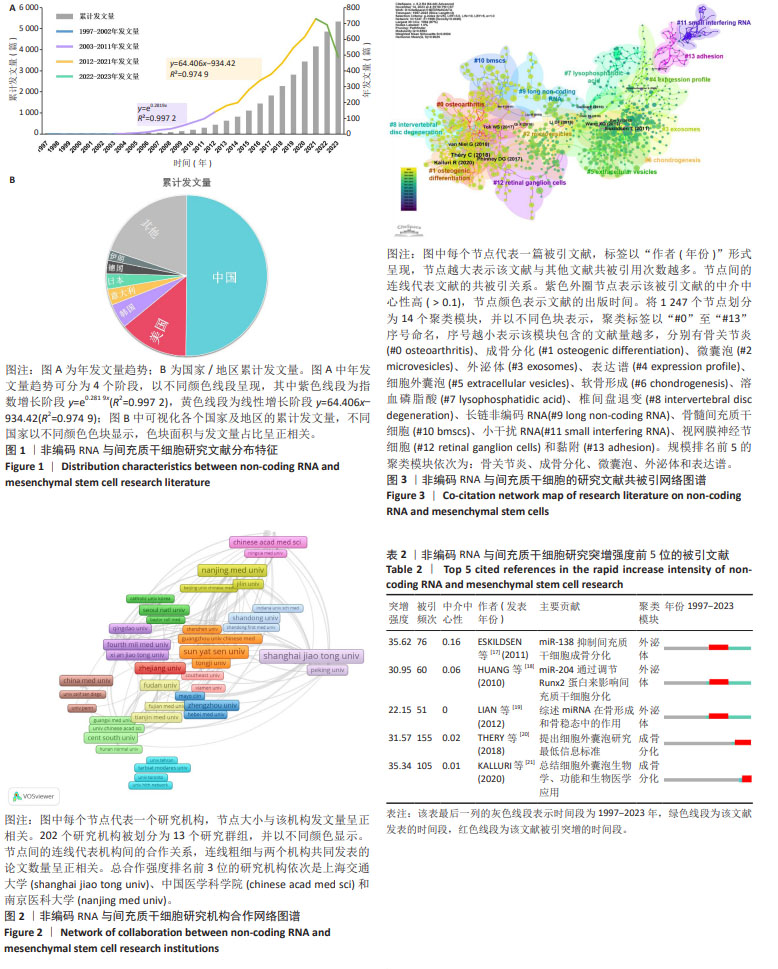
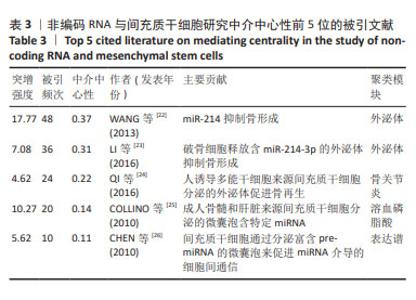
表3显示了高中介中心性的文献[22-26],且这些文献节点均位于聚类模块间,是连接网络中的个体节点以及连接聚类模块的重要节点。其中,中介中心性得分最高的是学者WANG 等[22]于2013年在《Nature Medicine》期刊上发表的论文,揭示miR-214抑制骨形成的机制,还有LI 等[23]于《Nature Communications》发表关于破骨细胞释放含miR-214-3p的外泌体抑制骨形成的文章,这2篇文章都位于外泌体(#3 exosomes)、微囊泡(#2 microvesicles)、细胞外囊泡(#5 extracellular vesicles)和长链非编码RNA(#9 long non-coding RNA)聚类模块交界处[22-23],见图3,为多个研究方向提供知识基础。QI等[24]发表的人诱导多能干细胞来源间充质干细胞分泌的外泌体能促进骨再生的体内实验研究划分为骨关节炎(#0 osteoarthritis)聚类,但其也位于微囊泡(#2 microvesicles)和骨髓间充质干细胞(#10 bmscs)模块的边界处,该文献为对连接着多个方向的研究起到重要作用。同样,COLLINO 等[25]揭示成人骨髓和肝脏来源间充质干细胞分泌的微囊泡含特定miRNA的研究位于溶血磷脂酸(#7 lysophosphatidic acid)、长链非编码RNA(#9 long non-coding RNA)和表达谱(#4 expression profile)等聚类模块间,以及CHEN等[26]发表关于间充质干细胞通过分泌富含微小RNA前体的微囊泡来促进微小RNA介导的细胞间通信的研究位于表达谱(#4 expression profile)、细胞外囊泡(#5 extracellular vesicles)、软骨形成(#6 chondrogenesis)和长链非编码RNA(#9 long non-coding RNA)等聚类模块间[26]。 "
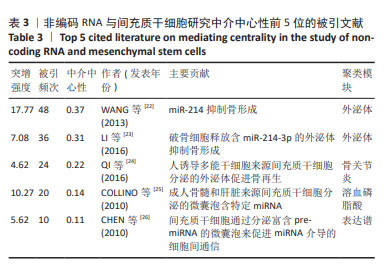
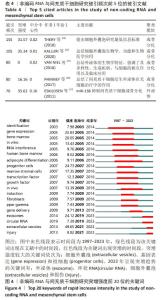
表4显示的是被引频次排名前5位的被引文献[17,20-21,27-28],主要涉及细胞外囊泡研究的相关综述和指南。其中被引频次最高的是国际细胞外囊泡协会于《Journal of Extracellular Vesicles》期刊上发布的细胞外囊泡研究的要求指南。该指南对细胞外囊泡相关实验提出要求,涉及分离纯化、组分鉴定、功能研究等内容[20]。 2.4 关键词突增分析及研究方向演变 对819个关键词进行分析,图4展示了突增强度排名前20的关键词,其中直至2023年,仍然保持突增趋势的关键词分别为外泌体(exosome)、环状RNA (circular RNA)、细胞外囊泡(extracellular vesicles)及损伤(injury),其中外泌体为细胞外囊泡的亚类。将关键词共现网络进行聚类分析,获得13个聚类,并以峰峦图呈现,见图5。峰峦图展示了各个研究方向随时间的演变。峰的高度表示该聚类在相应年份的发文量,反映了该研究方向的活跃水平,括号内为该研究方向直至2023年仍呈现突增趋势的关键词。近年来,成骨分化(#6 osteogenic differentiation)、 成脂(#8 adipogenesis)和 神经元分化(#9 neuronal differentiation)方向的研究热度明显降低。肿瘤微环境(#1 tumor microenvironment)、 骨关节炎(#4 osteoarthritis)、 氧化应激(#5 oxidative stress)、 细胞外囊泡(#10 extracellular vesicles)等方向有较高的研究热度。"
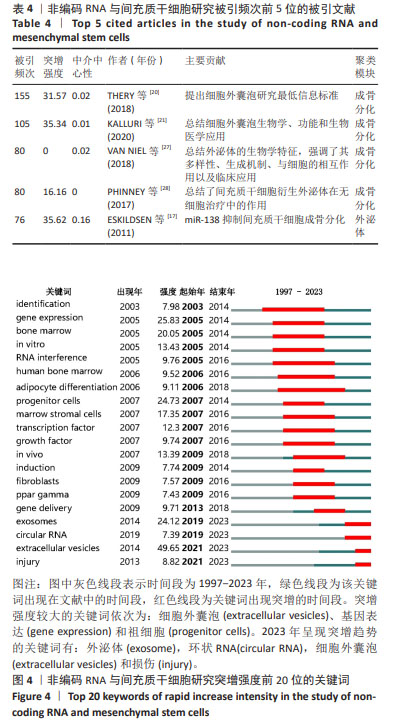
| [1] EDDY SR. Non–coding RNA genes and the modern RNA world. Nat Rev Genet. 2001;2(12):919-929. [2] PENG Y, CROCE CM. The role of microRNAs in human cancer. Sig Transduct Target Ther. 2016;1:15004. [3] SUN YM, CHEN YQ. Principles and innovative technologies for decrypting noncoding RNAs: from discovery and functional prediction to clinical application. J Hematol Oncol. 2020;13(1):109. [4] ZHAO C, XIE W, ZHU H, et al. LncRNAs and their RBPs: how to influence the fate of stem cells? Stem Cell Res Ther 2022;13(1):175. [5] HUNKLER HJ, GROSS S, THUM T, et al. Non-coding RNAs: key regulators of reprogramming, pluripotency, and cardiac cell specification with therapeutic perspective for heart regeneration. Cardiovasc Res. 2022; 118(15):3071-3084. [6] PITTENGER MF, DISCHER DE, PEAULT BM, et al. Mesenchymal stem cell perspective: cell biology to clinical progress. NPJ Regen Med. 2019;4:22. [7] GUO Y, YU Y, HU S, et al. The therapeutic potential of mesenchymal stem cells for cardiovascular diseases. Cell Death Dis. 2020;11(5):349. [8] WENG Z, ZHANG B, WU C, et al. Therapeutic roles of mesenchymal stem cell-derived extracellular vesicles in cancer. J Hematol Oncol. 2021;14(1):136. [9] CAI Y, WU C, OU Q, et al. Enhanced osteoarthritis therapy by nanoengineered mesenchymal stem cells using biomimetic CuS nanoparticles loaded with plasmid DNA encoding TGF-beta1. Bioact Mater. 2023;19:444-457. [10] LI Z, LIN Z, LIU S, et al. Human mesenchymal stem cell-derived miniature joint system for disease modeling and drug testing. Adv Sci. 2022;9(21):e2105909. [11] DONTHU N, KUMAR S, MUKHERJEE D, et al. How to conduct a bibliometric analysis: an overview and guidelines. J Bus Res. 2021;133: 285-296. [12] YING L, MINDEN V, DAMLE A. Simple, direct and efficient multi-way spectral clustering. Inf Inference. 2019;8(1):181-203. [13] FREEMAN LC. A set of measures of centrality based on betweenness. Sociometry. 1977;40(1):35-41. [14] SMALL H. Co‐citation in the scientific literature: a new measure of the relationship between two documents. J Assoc Inf Sci. 2007;24(4): 265-269. [15] CHEN C, IBEKWE‐SANJUAN F, HOU J. The structure and dynamics of cocitation clusters: a multiple‐perspective cocitation analysis. J Assoc Inf Sci Technol. 2010;61(7):1386-1409. [16] 陈悦,陈超美,刘则渊,等.CiteSpace知识图谱的方法论功能[J].科学学研究,2015,33(2):242-253. [17] ESKILDSEN T, TAIPALEENMAKI H, STENVANG J, et al. MicroRNA-138 regulates osteogenic differentiation of human stromal (mesenchymal) stem cells in vivo. Proc Natl Acad Sci U S A. 2011; 108(15):6139-6144. [18] HUANG J, ZHAO L, XING L, et al. MicroRNA-204 regulates Runx2 protein expression and mesenchymal progenitor cell differentiation. Stem Cells. 2010;28(2):357-364. [19] LIAN JB, STEIN GS, VAN WIJNEN AJ, et al. MicroRNA control of bone formation and homeostasis. Nat Rev Endocrinol. 2012;8(4):212-227. [20] THERY C, WITWER KW, AIKAWA E, et al. Minimal information for studies of extracellular vesicles 2018 (MISEV2018): a position statement of the international society for extracellular vesicles and update of the MISEV2014 guidelines. J Extracell Vesicles. 2018;7(1):1535750. [21] KALLURI R, LEBLEU VS. The biology, function, and biomedical applications of exosomes. Science. 2020;367(6478):eaau6977. [22] WANG X, GUO B, LI Q, et al. miR-214 targets ATF4 to inhibit bone formation. Nat Med. 2013;19(1):93-100. [23] LI D, LIU J, GUO B, et al. Osteoclast-derived exosomal miR-214-3p inhibits osteoblastic bone formation. Nat Commun. 2016;7:10872. [24] QI X, ZHANG J, YUAN H, et al. Exosomes secreted by human-induced pluripotent stem cell-derived mesenchymal stem cells repair critical-sized bone defects through enhanced angiogenesis and osteogenesis in osteoporotic rats. Int J Biol Sci. 2016;12(7):836-849. [25] COLLINO F, DEREGIBUS MC, BRUNO S, et al. Microvesicles derived from adult human bone marrow and tissue specific mesenchymal stem cells shuttle selected pattern of miRNAs. PLoS One. 2010;5(7):e11803. [26] CHEN TS, LAI RC, LEE MM, et al. Mesenchymal stem cell secretes microparticles enriched in pre-microRNAs. Nucleic Acids Res. 2010; 38(1):215-224. [27] VAN NIEL G, D’ANGELO G, RAPOSO G. Shedding light on the cell biology of extracellular vesicles. Nat Rev Mol Cell Biol. 2018;19(4):213-228. [28] PHINNEY DG, PITTENGER MF. Concise review: MSC-derived exosomes for cell-free therapy. Stem Cells. 2017;35(4):851-858. [29] KOKOL P, BLAZUN VOSNER H, ZAVRSNIK J. Application of bibliometrics in medicine: a historical bibliometrics analysis. Health Info Libr J. 2021; 38(2):125-138. [30] BORNMANN L, MUTZ R. Growth rates of modern science: a bibliometric analysis based on the number of publications and cited references. J Assoc Inf Sci Technol. 2015;66(11):2215-2222. [31] MICHEEL J, SAFRASTYAN A, WOLLNY D. Advances in non-coding RNA sequencing. Noncoding RNA. 2021;7(4):70. [32] 李晟,王国佐,朱正刚,等.基于国家自然科学基金资助项目分析miR-23研究现状[J].中国老年学杂志,2023,43(5):1243-1246. [33] 刘田园,戴璇,石涵芬,等.2012-2022年国家自然科学基金骨质疏松相关项目研究分析[J].中国骨质疏松杂志,2023,29(8):1121-1128. [34] YU B, KIM HW, GONG M, et al. Exosomes secreted from GATA-4 overexpressing mesenchymal stem cells serve as a reservoir of anti-apoptotic microRNAs for cardioprotection. Int J Cardiol. 2015;182: 349-360. [35] GONG M, YU B, WANG J, et al. Mesenchymal stem cells release exosomes that transfer miRNAs to endothelial cells and promote angiogenesis. Oncotarget. 2017;8(28):45200-45212. [36] LEE JK, PARK SR, JUNG BK, et al. Exosomes derived from mesenchymal stem cells suppress angiogenesis by down-regulating VEGF expression in breast cancer cells. PLoS One. 2013;8(12):e84256. [37] KIM H, LEE MJ, BAE EH, et al. Comprehensive molecular profiles of functionally effective MSC-derived extracellular vesicles in immunomodulation. Mol Ther. 2020;28(7):1628-1644. [38] ZHOU W, ZHOU Y, CHEN X, et al. Pancreatic cancer-targeting exosomes for enhancing immunotherapy and reprogramming tumor microenvironment. Biomaterials. 2021;268:120546. [39] ZHU YG, FENG XM, ABBOTT J, et al. Human mesenchymal stem cell microvesicles for treatment of Escherichia coli endotoxin-induced acute lung injury in mice. Stem Cells. 2014;32(1):116-125. [40] MA Y, WANG J, WANG Y, et al. The biphasic function of microglia in ischemic stroke. Prog Neurobiol. 2017;157:247-272. [41] LIU L, LIU Y, FENG C, et al. Lithium-containing biomaterials stimulate bone marrow stromal cell-derived exosomal miR-130a secretion to promote angiogenesis. Biomaterials. 2019;192:523-536. [42] LIU W, YU M, CHEN F, et al. A novel delivery nanobiotechnology: engineered miR-181b exosomes improved osteointegration by regulating macrophage polarization. J Nanobiotechnol. 2021;19(1):269. [43] LIU YJ, WANG C. A review of the regulatory mechanisms of extracellular vesicles-mediated intercellular communication. Cell Commun Signal. 2023;21(1):77. [44] MEMCZAK S, JENS M, ELEFSINIOTI A, et al. Circular RNAs are a large class of animal RNAs with regulatory potency. Nature. 2013;495(7441): 333-338. [45] HANSEN TB, JENSEN TI, CLAUSEN BH, et al. Natural RNA circles function as efficient microRNA sponges. Nature. 2013;495(7441):384-388. [46] HE AT, LIU J, LI F, et al. Targeting circular RNAs as a therapeutic approach: current strategies and challenges. Sig Transduct Target Ther 2021;6(1):185. [47] SUN M, YANG Y. Biological functions and applications of circRNA-next generation of RNA-based therapy. J Mol Cell Biol. 2023;15(5):mjad031. [48] DOS SANTOS CC, AMATULLAH H, VASWANI CM, et al. Mesenchymal stromal (stem) cell therapy modulates miR-193b-5p expression to attenuate sepsis-induced acute lung injury. Eur Respir J. 2022;59(1): 2004216. [49] SUN Z, WU J, BI Q, et al. Exosomal lncRNA TUG1 derived from human urine-derived stem cells attenuates renal ischemia/reperfusion injury by interacting with SRSF1 to regulate ASCL4-mediated ferroptosis. Stem Cell Res Ther. 2022;13(1):297. [50] YU Z, WEN Y, JIANG N, et al. TNF-alpha stimulation enhances the neuroprotective effects of gingival MSCs derived exosomes in retinal ischemia-reperfusion injury via the MEG3/miR-21a-5p axis. Biomaterials. 2022;284:121484. [51] WECHSLER ME, SHEVCHUK M, PEPPAS NA. Developing a multidisciplinary approach for engineering stem cell organoids. Ann Biomed Eng. 2020;48(7):1895-1904. [52] WANG Y, ZONEFF ER, THOMAS JW, et al. Hydrogel oxygen reservoirs increase functional integration of neural stem cell grafts by meeting metabolic demands. Nat Commun. 2023;14(1):457. [53] YIN Z, QIN C, PAN S, et al. Injectable hyperbranched PEG crosslinked hyaluronan hydrogel microparticles containing mir-99a-3p modified subcutaneous ADSCs-derived exosomes was beneficial for long-term treatment of osteoarthritis. Mater Today Bio. 2023;23:100813. [54] SUNG YK, KIM SW. Recent advances in the development of gene delivery systems. Biomater Res. 2019;23(1):8. [55] TASSET A, BELLAMKONDA A, WANG W, et al. Overcoming barriers in non-viral gene delivery for neurological applications. Nanoscale. 2022;14(10):3698-3719. [56] KIM SJ, KO WK, HAN GH, et al. Axon guidance gene-targeted siRNA delivery system improves neural stem cell transplantation therapy after spinal cord injury. Biomater Res. 2023;27(1):101. [57] LIU S, LIU B, LI Q, et al. Transplantation of fibrin-thrombin encapsulated human induced neural stem cells promotes functional recovery of spinal cord injury rats through modulation of the microenvironment. Neural Regen Res. 2024;19(2):440-446. [58] WEI X, CAO S, MA W, et al. Intra-amniotic delivery of CRMP4 siRNA improves mesenchymal stem cell therapy in a rat spina bifida model. Mol Ther Nucleic Acids. 2020;20:502-517. |
| [1] | Liang Haobo, Wang Zeyu, Ma Wenlong, Liu Hao, Liu Youwen. Hot issues in the field of joint revision: infection, rehabilitation nursing, bone defect, and prosthesis loosening [J]. Chinese Journal of Tissue Engineering Research, 2025, 29(9): 1963-1971. |
| [2] | Yu Jingbang, Wu Yayun. Regulatory effect of non-coding RNA in pulmonary fibrosis [J]. Chinese Journal of Tissue Engineering Research, 2025, 29(8): 1659-1666. |
| [3] | Yang Zhihang, Sun Zuyan, Huang Wenliang, Wan Yu, Chen Shida, Deng Jiang. Nerve growth factor promotes chondrogenic differentiation and inhibits hypertrophic differentiation of rabbit bone marrow mesenchymal stem cells [J]. Chinese Journal of Tissue Engineering Research, 2025, 29(7): 1336-1342. |
| [4] | Hu Taotao, Liu Bing, Chen Cheng, Yin Zongyin, Kan Daohong, Ni Jie, Ye Lingxiao, Zheng Xiangbing, Yan Min, Zou Yong. Human amniotic mesenchymal stem cells overexpressing neuregulin-1 promote skin wound healing in mice [J]. Chinese Journal of Tissue Engineering Research, 2025, 29(7): 1343-1349. |
| [5] | Jin Kai, Tang Ting, Li Meile, Xie Yuan. Effects of conditioned medium and exosomes of human umbilical cord mesenchymal stem cells on proliferation, migration, invasion, and apoptosis of hepatocellular carcinoma cells [J]. Chinese Journal of Tissue Engineering Research, 2025, 29(7): 1350-1355. |
| [6] | Li Dijun, Jiu Jingwei, Liu Haifeng, Yan Lei, Li Songyan, Wang Bin. Three-dimensional gelatin microspheres loaded human umbilical cord mesenchymal stem cells for chronic tendinopathy repair [J]. Chinese Journal of Tissue Engineering Research, 2025, 29(7): 1356-1362. |
| [7] | Liu Qi, Li Linzhen, Li Yusheng, Jiao Hongzhuo, Yang Cheng, Zhang Juntao. Icariin-containing serum promotes chondrocyte proliferation and chondrogenic differentiation of stem cells in the co-culture system of three kinds of cells [J]. Chinese Journal of Tissue Engineering Research, 2025, 29(7): 1371-1379. |
| [8] | Zhang Zhenyu, Liang Qiujian, Yang Jun, Wei Xiangyu, Jiang Jie, Huang Linke, Tan Zhen. Target of neohesperidin in treatment of osteoporosis and its effect on osteogenic differentiation of bone marrow mesenchymal stem cells [J]. Chinese Journal of Tissue Engineering Research, 2025, 29(7): 1437-1447. |
| [9] | Lyu Liting, Yu Xia, Zhang Jinmei, Gao Qiaojing, Liu Renfan, Li Meng, Wang Lu. Bibliometric analysis of research process and current situation of brain aging and exosomes [J]. Chinese Journal of Tissue Engineering Research, 2025, 29(7): 1457-1465. |
| [10] | Xie Liugang, Cui Shuke, Guo Nannan, Li Aoyu, Zhang Jingrui. Research hotspots and frontiers of stem cells for Alzheimer’s disease [J]. Chinese Journal of Tissue Engineering Research, 2025, 29(7): 1475-1485. |
| [11] | Chang Jinxia, Liu Yufei, Niu Shaohui, Wang Chang, Cao Jianchun. Visualization analysis of macrophage polarization in tissue repair process [J]. Chinese Journal of Tissue Engineering Research, 2025, 29(7): 1486-1496. |
| [12] | Li Jialin, Zhang Yaodong, Lou Yanru, Yu Yang, Yang Rui. Molecular mechanisms underlying role of mesenchymal stem cell secretome [J]. Chinese Journal of Tissue Engineering Research, 2025, 29(7): 1512-1522. |
| [13] | Cao Yue, Ye Xinjian, Li Biyao, Zhang Yining, Feng Jianying. Effect of extracellular vesicles for diagnosis and therapy of oral squamous cell carcinoma [J]. Chinese Journal of Tissue Engineering Research, 2025, 29(7): 1523-1530. |
| [14] | He Bo, Chen Wen, Ma Suilu, He Zhijun, Song Yuan, Li Jinpeng, Liu Tao, Wei Xiaotao, Wang Weiwei, Xie Jing . Pathogenesis and treatment progress of flap ischemia-reperfusion injury [J]. Chinese Journal of Tissue Engineering Research, 2025, 29(6): 1230-1238. |
| [15] | Li Huijun, Li Huangyan, Zhang Yeting. Physical activity and cognition in older adults: research hotspot and topic evolution [J]. Chinese Journal of Tissue Engineering Research, 2025, 29(5): 1073-1080. |
| Viewed | ||||||
|
Full text |
|
|||||
|
Abstract |
|
|||||
